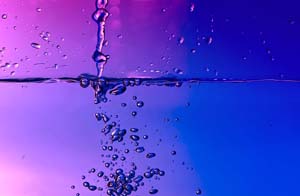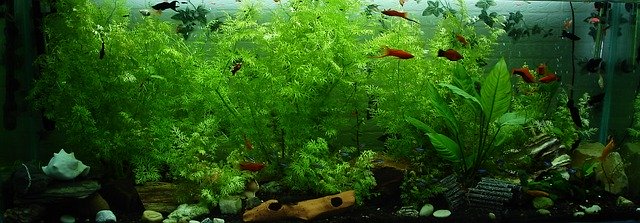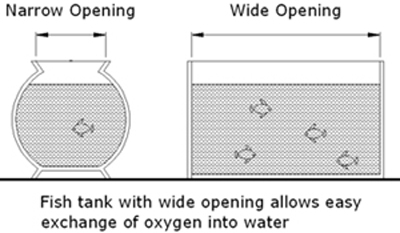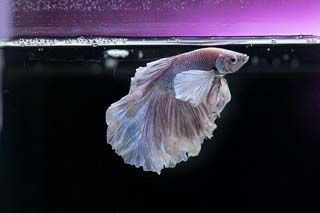 If your fish is gasping for air at the top of the tank then the very obvious reason for this is that the water doesn’t have enough oxygen present in it and the fish is trying to get it from the upper water layers of the tank where exchange of air between fish tank water and surrounding atmosphere happens best.
If your fish is gasping for air at the top of the tank then the very obvious reason for this is that the water doesn’t have enough oxygen present in it and the fish is trying to get it from the upper water layers of the tank where exchange of air between fish tank water and surrounding atmosphere happens best.
When you have a bubbler in the fish tank it throws outside oxygen though an air stone into water that rises above on surface of the fish tank water. Because of this the surface gets disturbed and surrounding air gets mixed with fish tank water. The role of this bubbler is to disturb the surface of the water surface so that enough oxygen gets exchanged into fish tank water. Fish survive on this mixed air exchange between the water and surrounding air.
If you see just one fish gasping for air at the top near the surface then may be because he’s sick because of parasites and needs treatment, but if you see several fish hanging near top surface, gasping for air then there needs to be done something about it.
Unfortunately there is no equipment or a measure that shows if the levels of mixed oxygen have reduces or at perfect level so the only sign to know something has gone wrong is by looking at fish that are gasping for air at the top surface of the fish tank. If your fish tank is well maintained with good frequency of cleaning and checking all the equipments is working properly or not, then you will rarely get this problem of lower oxygen levels.
Table of Contents
How do I know my fish tank water has less oxygen?
There are many symptoms that fish themselves show when oxygen levels decrease.
- Movement of fish reduces and they become slightly sluggish.
- They try to move their gills more often and fast because they try to collect more oxygen from surrounding water.
- If nothing helps and oxygen levels are not improved then they will move to the top of fish tank because this is where more and more exchange of oxygen takes place.
There is more than one reason why your aquarium fish is gasping for air at the top surface of your tank. Some of the most common reasons could be
- Bad aeration (the most common reason) and lack of sufficient mixed air in the fish tank water.
- Excessive algae growth inside fish tank
- May be your fish is sick because of parasites.
- Bad quality or damaged filter causing altered water chemistry
- More than 10 degrees of temperature difference throughout the day. In case of tropical fish since water is warmer it hold less mixed oxygen as compared to cold water and needs more aeration quantity.
- Too many fish in your fish tank causing overcrowding. This is a very obvious reason because to many fish will be competing for the same amount of mixed oxygen in fish tank water.
Improving Aeration In Fish Tank
Improving aeration in fish tank includes checking if your bubble machine is working continuously without any interruptions or not. Some bubbling machines have a kind of throttle to adjust the quantity of air that gets through the tube and out from the air stone. See to it that enough air is getting mixed in the water and rising to the surface.
Sometimes kids have a tendency to play with this throttle like knob to see if it’s working or not and they tend to forget or are not informative enough that these smaller things can have a big effect in the entire aquarium set up. So be extra careful about even such smaller things when you check what’s going on with the quantity of air that is getting though the air stone.
If you have an overcrowded fish tank then obviously you’ll need to consider more than one bubbling machine to cater to increased demand of oxygen in fish tank water. Another reason why you’ll probably need another bubbling machine is a bigger sized fish tank. If you tank is of bigger size then obviously it will need more amount of oxygen for the fish to survive and hence adding one more machine will definitely help.
Installing a Bubbler vs a Power head
An alternative to using a bubbler machine is to use a power head that agitates the surface of water. Many fish tank owners who have marine tank avoid using bubblers because when bubbles rise to the surface they splash some water on adjacent walls and when this water droplets dry, they leave a stain of salt on the inside of the glass walls, which looks ugly. However a power head can produce strong water current water tank and is not recommended for smaller sized tanks.
Shift To a Planted Tank But With Precautions.

However shifting to a planted tank can be a big step and careful planning is needed right from picking up perfect plant species to carefully adding them to the substrate. Another very important factor if you plan to have a planted tank is that it will require additional artificial lighting for plant growth and this is an added extra cost that must be considered. While making use of artificial lights avoid using incandescent lights and go with LED lights because they produce fresh light and less heat.
Avoid Treating Diseased Fish In your Main Tank.
If you find any of the fish has a kind of disease then shift him to a quarantine tank and treat him there. Adding chemical to your main tank can affect oxygen level even if it s safe for the fish species.
Have a Fish Tank with Wider Opening On Top
Apart from having an up to date and properly working machine you must also thing of getting a tank that has wider opening on top. One bad example of faulty tank is a “glass bowl”. A glass bowl must be having the same volume as that of a rectangular fish tank but it has a narrow opening on top which prevents enough exchange of oxygen at the surface level and must never be used as a fish tank.
A rectangular fish tank with a wide opening on top allows correct and enough amount of oxygen to mix well on the surface and help healthy survival of fish.

Avoid Overcrowding Of Fish
The number one reason for lowered oxygen levels if everything else is going well in your fish tank is overcrowding. Stocking too many fish will definitely create problems because all these fish will be competing for same amount of oxygen getting mixed in the water. If you have a community tank then obviously different species will have different metabolism and will require different quantities of oxygen to survive in the same space.
When you tank is overcrowded then the normal tendency is to put more food for more fish. This can be a huge problem because the unconsumed food gets rotten at the bottom and alter water chemistry.
Improving Water Quality
Having a good quality water testing kit is a must in these cases. Start by performing all the necessary tests of your fish tank water like pH levels, ammonia, nitrates and nitrites levels. Also check if chlorine levels and act on the numbers.
Here is a recommended water testing kid for all your requirements
(paidlink)
API Freshwater Master Test Kit, 3 Pack
In case of bad quality water some of the qualities are visible to eyes such as “cloudy water” or “too much growth of algae”, but some qualities such as high ammonia levels and altered pH levels cannot be recognized with eyes and in such cases having a “API Freshwater Master Test Kit, 3 Pack” (paidlink) greatly helps.
Water changes will definitely improve oxygen levels as new water is being added to the existing one. Depending upon test results of the “water testing kit” you can go in for 20 to 25% water changes and if the numbers are too disturbing even 50% water change.
If you find the numbers from the water testing kit are not normal then you must act immediately. If you find ammonia levels are not good in fish tank water then this can be a big trouble because ammonia levels can cause damage to fish gills and this is where problem starts. Fish breathe from not nose but gills and if gills are not healthy then enough oxygen will not pass through them. This will make the fish swim to top and gasp for air.
Too Much Algae Growth in Fish Tank
Too much algae growth in fish tank will turn water greenish and fish tank cloudy. The primary reason of too much algae growth is that your fish tank s getting too much direct sunlight.
Many times it’s impossible to move your fish to a new location because of several reasons and is not advisable in such cases. What you can do is cover your windows or doors from where direct sunlight is entering the room with curtains and check the difference. A simple water change with some careful measures to reduce the direct amount of sunlight falling on your aquarium can make a big difference in these cases.
Maintain Consistent Water Temperature in a Tropical Fish Tank
When water gets warmer it will tend to hold less oxygen in dissolved form and this can make your aquarium fish gasp for air. You must have a thermometer attached to the fish tank to check the temperature levels of fish tank water. For a tropical fish tank the ideal temperature levels are about 24 to 28 degrees Celsius ( 75-82 Fahrenheit). If you find that water temperature levels are well above 30 degrees then this can be a great problem and can be a cause for lesser oxygen levels.
Immediately check whether your heater is working properly or not. If it is malfunctioning then get it repaired or get a new one. Reducing oxygen in water is a serious problem for all fish species and death can occur because of this.
Is Your Fish Sick?
Your fish is gasping for air because probably he’s infected with parasites. Other symptoms of a fish getting infected with parasites are getting white patches, cloudy eyes and they gasp for air at the top surface.
If all other things in your fish tank like water quality, good working equipments is in place and if you still fish that fish is gasping for air then you can check signs and symptoms of a parasite infection and move him to a quarantine tank immediately.
Disease That Affects And Infect Gills Of Fish.
Flavobacteria Infection
Symptoms – Rapid breathing, lost appetite, little to no eating, swollen gills
Causes – Overcrowded tank, increased temperature of water
Treatment – Potassium permangane, fish tank salt in a quarantine tank. Antibiotics if conditions are savior
Gill Parasites –
When parasites attack fish they primarily attack on gills, because most parasites thrive on blood of the fish. Normally you’ll see symptoms like fish rapidly moving gills and they will look like torn or chewed. Because of damaged gills the fish will have difficulty breathing and will gasp for air on top surface of the water. Sometimes the fish will breath heavier than normal.
If the parasites reproduce themselves on the surface of the fish gills, then the color of the gills will become reddish and the fish will start rubbing it’s body against objects and decorating items because of the itching.
Some of the common parasites that thrive on gills are leeches and in case of seawater fish “gnathiid isopods.” Some other commonly found parasites that thrive on fish blood and can cause gill diseases are
- Gyrodactylus salaris
- Kudoa thyrsites (for marine fish)
- Cymothoa exigua (This parasite affectc tounge of the fish)
- Carp lice
Everything Looks Good, but Still My Fish Is Gasping for Air At The Top Surface of Water
Certain fish species like Bettas and Gouramis have a normal tendency to swim for air on top surface and should not be confused with lower oxygen levels. If you find these fish swimming at the top of the fish tank then it’s their normal behavior.

